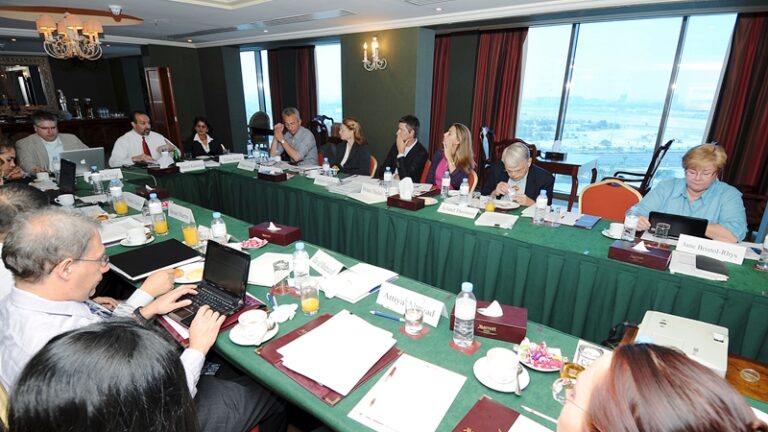Focused Discussions, Race & Society, Regional Studies
Migrant Labor in the Gulf - Working Group III

On October 10–11, 2010, CIRS held its third and final meeting of the “Migrant Labor in the Gulf” working group. Each participant submitted a draft paper in advance of the meeting. The goal of the meeting was for those taking part to critique each other’s work and advise the authors as they prepare a final draft for submission to a planned edited volume titled Migrant Labour in the Gulf (Columbia University Press/Hurst, 2012).
CIRS launched the “Migrant Labor in the Gulf” initiative in 2008. The working group is composed of experts in the field of migrant labor who hail from a variety of different academic disciplines, including anthropology, sociology, history, and political science. The working group is also composed of the four CIRS Research Grant awardees: Andrew Gardner from the University of Puget Sound/Qatar University, Arland Thornton and Nathalie Williams from the University of Michigan, Susan Martin from Georgetown University, and David Mednicoff from the University of Massachusetts-Amherst.
The participants adopted different perspectives on migrant labor. Some focused on macro trends that drive migration and define labor patterns within the GCC and among sending countries. In addition, several participants employed ethnographic methods to analyze the lived experiences of the migrants themselves.
The term “migrant labor” was historicized in order to analyze how the relationship between the citizen and the migrant in the Gulf has traditionally centered around the question of labor. Connections between the Gulf and other parts of the world were built around the pearling industry, trade, kinship relations, and religion. Migrant labor is usually depicted as a transient activity, and although many laborers are indeed short-term employees, this masks the fact that there are long-term and more culturally and socially-integrated forms of labor that exist in the Gulf. Importantly, historicizing migrant labor in the Gulf is useful in pointing out all the actors that are often excluded from discussions. Racialized hierarchical systems can be attributed to British colonial relations, and the establishment of the multinationals and the oil industry in the region.
Further, the participants examined the issue of gender in relation to migrant labor. Migrant labor in the Gulf tends to be highly gendered, where construction work and public sector work is dominated by males, and domestic work is performed by females. In general, and not just in the Gulf, domestic work falls outside of the purview of a country’s labor laws because domestic work is not considered part of the market economy. However, the participants argued that including domestic work within the framework of labor was not necessarily a solution to the problems associated with this type of employment. Here, the participants agreed that migrants should not be examined solely in terms of labor, but their social relations, political beliefs, and social formations should be examined as well.
Another key discussion was based on GCC states’ nationalization plans. The researchers spoke about the importance of not overlooking these schemes as the development of local human resources is a main target for most Gulf nations in the future. There has been little research regarding these nationalization schemes because of the difficulties of their implementation. As the Gulf strives toward knowledge based economies, long-term development is regarded as the responsibility of the national workforce. Although the nationalization strategies of the GCC countries differ, nationalization policies are geared towards breaking decades-long dependence on foreign labor in both the public and private sectors. In future, lower illiteracy rates, better global technological connectivity, and more women in leadership roles all pave the way for increased diversification of the Gulf economies.
The working group addressed other significant issues such as the ‘kefala’ system, human trafficking, illegal migration, and regional regulation efforts. The participants relied on a variety of data sources, including in-depth interviews, field observation, survey research, as well as demographic and other statistical data. The edited volume will be the first of its kind to be produced within the region.
- Click here for the working group’s agenda
- Read about the working group’s first and second meeting
- Read more about this research initiative
Participants include:
Attiya Ahmad, Wesleyan UniversityZahra Babar, Georgetown University School of Foreign Service in QatarMary Breeding, The World BankJane Bristol-Rhys, Zayed UniversityJohn T. Crist, Georgetown University School of Foreign Service in QatarAndrew Gardner, University of Puget SoundMehran Kamrava, Georgetown University School of Foreign Service in QatarPardis Mahdavi, Pomona CollegeSusan Martin, Georgetown UniversityDavid Mednicoff, University of Massachusetts–AmherstSuzi Mirgani, Georgetown University School of Foreign Service in QatarCaroline Osella, School of Oriental and African Studies, University of LondonFilippo Osella, University of SussexKasim Randeree, Oxford UniversityHélène Thiollet, Sciences PoArland Thornton, University of Michigan, Ann ArborNathalie E. Williams, University of Michigan, Ann Arbor
Article by Suzi Mirgani, CIRS Publications Coordinator